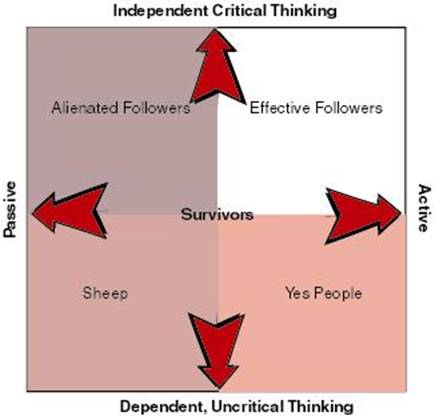|
Follow the Leader? It’s a New Game!
“Leaders rarely use their power wisely or effectively over
long periods unless they are supported by followers who have the
stature to help them do so.” – Ira Chaleff, The Courageous
Follower, Berrett-Koehler Publishers, Inc., 2003
Organizations are successful or not partly on the basis of how
well their leaders lead, but also in great part on the basis of
how well their followers follow. Surely improving the performance
of followers should be worthwhile. What is the role of the follower
and how does it affect leadership behavior and effectiveness? How
can members of the executive team participate more effectively
to create a truly dynamic partnership relationship with their leader?
When there is a crisis, when a company
fails or commits some malfeasance, everyone cries out: “How could that have happened here? How
come nobody said anything?” Followers have a responsibility
to speak up.
No matter how much partnership and
empowerment there is; the CEO has ultimate authority and responsibility.
What are the responsibilities
of the CEO’s followers? The
most capable team members fail when they gripe about their leader
but do not say or do anything to help him or her improve or get
back on track. This requires courage and skill.
What distinguishes an effective follower from an ineffective one
is intelligent, responsible and enthusiastic participation in the
pursuit of an organizational goal, according to Robert E. Kelly
(Harvard Business Review, Nov.-Dec. 1988).
The movement away from command and
control leadership has brought new leadership styles that are
more democratic and coach-like. The
terms “shared leadership,” and “servant leader” are
used to describe some of these new ways of interacting. There are
also new ways of interacting in the follower role. Setting aside
possible aversion to the term, the new flatter business organization
requires more responsible followers.
Managing the Boss
It is difficult to appreciate the pressures on the leader unless
you have had that position. While ego-strength is a quality to
be desired in a leader, it can easily be reinforced and deformed
into ego-driven. The pressures at the top need to be managed. Responsible
followers can help leaders stay on track and manage their decision-making
processes in the right direction. Responsible and effective followers
have an important role in order to maintain the desired partnering
dynamics.
Many executives do some of these things
quite naturally. But often the
executive team members are hesitant to speak up when the leader
makes mistakes, whether they are made from the best of intentions
or the worst. After all, “She’s (or he’s) the
boss.” Although we’ve grown beyond an authoritarian
leadership model where followers have no accountability, we haven’t
yet developed a model for responsible participation at the follower
level for the new leadership styles.
Teaching is another example in which
there is a symbiotic relationship: you can’t have an effective teacher without responsive students.
Teachers and students form a
learning circle around a body of knowledge or skills. Leaders
and followers form an action circle around a common purpose.
You can’t have effective leaders without
responsive followers.
The Job of Effective Followers
The sooner we recognize and accept our powerful position as followers,
the sooner we can fully develop responsible, synergistic relationships
in our organizations. According to Ira Chaleff (The Courageous
Follower, 2003), there are three things we need to understand in
order to fully assume responsibility as followers.
| 1 |
Understand
our power and how to use it.
As followers, we have far more power than we usually acknowledge.
We must understand the sources of our power, whom we serve
and the tools we have to achieve the group’s mission.
We have a unique vantage point as follower or team member,
but we have to know that and use it. |
| 1 |
Appreciate
the value of the leader and
the contributions he or she makes to forward the organization’s mission. We need to understand
the pressures upon the leader that can wear down creativity,
good humor and resolve. We can learn how to minimize these
forces and contribute to bringing out the leader’s strengths
for the good of the group and the common purpose. |
| 1 |
Work
toward minimizing the pitfalls of power by helping the leader
to remain on track for the long-term common good. We are all
witness to how power can corrupt, and it takes courage and
skill to speak up. We can learn how to counteract the dark
tendency of power. Feedback to the leader is necessary for
the new leadership styles to be effective. |
Five Followership Patterns
Robert E. Kelley, in his landmark article
for HBR “In Praise
of Followers” (1988), describes the behaviors that lead to
effective followership. He defines two dimensions that underlie
effective followership: the degree to which a person exercises
independent, critical thinking, and the degree of active or passive
participation. He describes five followership patterns.
Sheep, as Kelley calls them, are passive and uncritical. These
followers lack initiative and a sense of responsibility. They perform
the required task and then stop.
Yes People appear livelier but are equally un-enterprising. They
depend on the leader for inspiration and can be aggressively deferential,
even servile. Some leaders like them and can even form alliances
with them that can stifle creativity and energy.
Alienated Followers are critical and independent thinkers but
take a passive stance. They are cynical but perform with disgruntled
acquiescence. They seldom actively oppose or speak up.
Survivors are
those followers who go along with the leaders, usually because
they believe “it is better to be safe than sorry.” They
are adept at surviving change.
Effective Followers perform with energy and assertiveness. They
are critical, independent thinkers and will proactively challenge
decisions. They are risk-takers and problem solvers. They can usually
work without strong leadership.
According to Kelley, “In an organization
of effective followers, a leader tends to be more an overseer
of change and progress than a hero. As
organizational structures flatten, the quality of those who follow
will become more and more important.”
There are four essential qualities of effective followers.
| 1 |
They
manage themselves well: The key to being effective as a follower
is paradoxically the ability to think for oneself. Followers
also see themselves as equals to the leader they follow. |
| 1 |
They
are committed to a higher purpose: They work towards the purpose
of the organization, and to certain principles and values outside
of themselves. If they see a misalignment with personal values,
they may withdraw their support either by changing jobs or
by changing leaders. |
| 1 |
They
build their strengths: They have high standards of performance
and are continually learning and updating their skills and
abilities. They seek out extra work and responsibilities gladly
in order to stretch themselves. |
| 1 |
They
take risks: They are credible, honest and have the courage
to speak up. They give credit where due, but also admit mistakes.
They are insightful and candid and they are willing to take
risks. They can keep leaders and colleagues honest and informed. |
In information-age organizations, hundreds of decentralized units
process and rapidly act on varied input within the design and purpose
of the organization. This requires an entirely different relationship
between leaders and followers.
Speaking Up to the Boss
Part of the problem in following responsibly
and pro-actively lies in the tendency for people to relate to
authority figures as they would in a parent-child relationship.
Early childhood memories are
deeply embedded in the subconscious and trigger emotions in a
split second. These memories are often out of our awareness,
and it doesn’t take much-- a look, a tone of voice-- to
trigger anger or anxiety when confronted by the boss. Developing
one’s degree of emotional intelligence can help regulate
these split second reactions and allow more logical and appropriate
interactions.
The danger in the leader-follower relationship
is the assumption that the leader’s interpretation must dominate. If
this assumption exists on the part of either the leader or the
follower, both are at risk. The leader’s openness will
diminish. Followers will easily lose their unique perspective
and abandon healthy disagreement. Creativity and problem-solving
processes become stifled.
It is obviously not an easy task to speak up and challenge the
leader, but without the courage and skill to do so, corporate scandals
can ensue. Giving candid feedback to the boss is a skill that is
not practiced as often as necessary. Working with a neutral party
such as a consultant or executive coach can help a follower or
executive team member to act courageously and effectively.
Resources for Follow the Leader
| • |
Chaleff,
I. (2002). The Courageous Follower, Standing up to & for
Our Leaders. (2 nd ed.). San Francisco, CA: Berrett-Koehler
Publishers, Inc. |
| • |
Goleman,
D., Boyatzis, R., & McKee, A. (2002). Primal Leadership,
Realizing the Power of Emotional Intelligence. Boston: Harvard
Business School Press. |
| • |
Greenleaf,
R. K. (1998). The Power of Servant Leadership. San Francisco,
CA: Berrett-Koehler Publishers, Inc. |
| • |
Kelley,
R. E. (1988, Nov.-Dec.). In Praise of Followers. Harvard Business
Review. Reprint 88606. |
Working
Resources is a Leadership Consulting, Training and Executive Coaching
Firm Helping Companies Assess, Select, Coach and Retain Emotionally
Intelligent People; Emotional Intelligence-Based Interviewing and
Selection; Multi-Rater 360-Degree Feedback; Career Coaching; Change
Management; Corporate Culture Surveys and Executive Coaching.
Dr. Maynard Brusman
Consulting Psychologist and Executive Coach
Trusted Advisor to Senior Leadership Teams
Subscribe to Working Resources FREE E-mail Newsletter.
E-mail:mbrusman@workingresources.com . Type Subscribe Newsletter.
Voice: 415-546-1252 Web:www.workingresources.com
E-mail This Article to a Collegue...
Return
to Professional Effectiveness Articles Index
|





